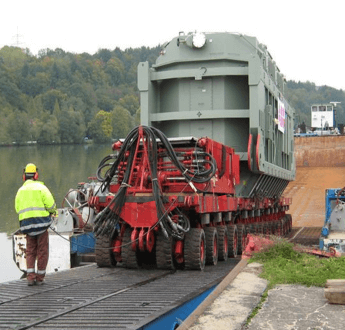
BLOG: Lift stability and transport stability: determining elasticity
What do barges and SPMTs have in common? More than you think. Stability is essential for safety in lift operations as well as in SPMT operations. How do you determine stability? In both cases, adding up elasticities is essential.


The operations in the pictures don’t have much in common at first sight. But the opposite is true. In both types of operations, safe execution depends in part on stability. Specifics like mass and center of gravity are crucial when determining safety in lift operations and SPMT operations. The examples shown in these pictures are illustrative and depict safe situations.
Rules of thumb for stability
Stability is a complicated subject. In cases where stability is not the greatest issue, you may decide on stability by one of these two simple rules of thumb.
- GM value (metacentric height) for barges
- Minimum tipping angle for trailers
In operations in which stability is a critical issue, these simple rules do not suffice. To determine stability in these cases, it is necessary to quantify all elasticities that play a role.
Quantification of elasticity in lift and SPMT operations
The quantification of ‘elasticity’ is the common factor in lift operations and in SPMT operations. How do you determine all elasticities from top to bottom? For the barge, total elasticity is the sum of crane elasticity (bending) and the elasticity of the barge against rolling. In this so-called ‘roll stiffness’ of the barge the GM value plays a major role. For the trailer, it is the combination of bending elasticity of the ramps, the elasticity of the tires and the elasticity of the hydraulic setting. 3 point and 4 point hydraulic tilts have different tipping lines, and a different elasticity occurs for different hydraulic layouts.
From elasticity to stability to safe operations
You have quantified all elasticities and all external influences (wind, moments, and other forces) are known. Now you can calculate all movements and rotations of the operation. These movements can easily be judged as acceptable or not. This establishes a clear basis for operations in which stability is critical.
Upcoming events
What we do
As an independent partner, we advise about, design and construct everything from concept study to project completed. Our in-house developed design software calculates everything concerning mobile cranes and bespoke heavy equipment, while our people offer the expertise and skills that secure your success.
GET YOUR PROJECT PREPARED
Consultancy / Design & Construction
Our 40 years of experience provides the basis of a successful start of your project: right from the FEED phase. Preparation is vital. Therefore our concept studies, method statements and mission equipment offer you all the support you need.
GET YOUR PROJECT EXECUTION SUPPORTED
Consultancy / Design & Construction
Our aim is to optimize your project team’s results. With our exclusive knowledge of lifting and transportation we eliminate and manage risks. This is how we reach our collective goal: Zero Accidents, Zero Incidents.
DESIGN OF LIFTING & TRANSPORT ASSETS
Engineering
We have built up a great deal of experience with the design of (mobile) cranes and bespoke heavy equipment such as piling machines and excavators. Our customer base includes the most prominent producers of cranes and heavy machinery worldwide.
We are eager to hear from you
Call +31 (0) 30 240 80 60 or use the contact form. We always respond within 24 hours.